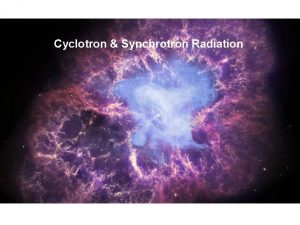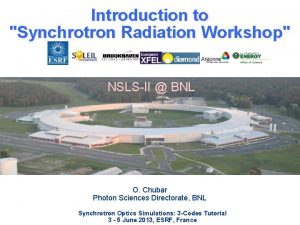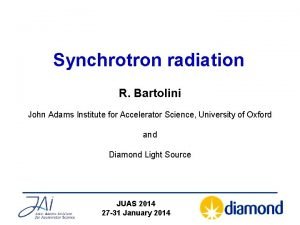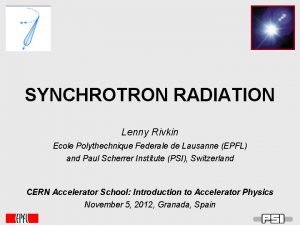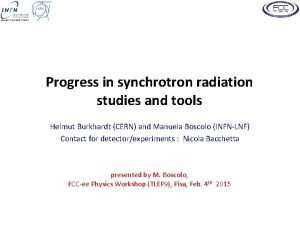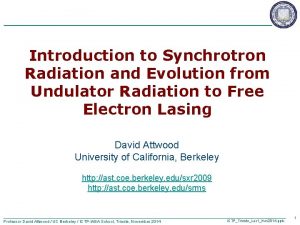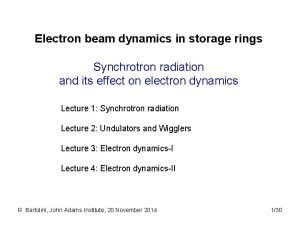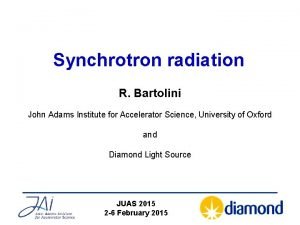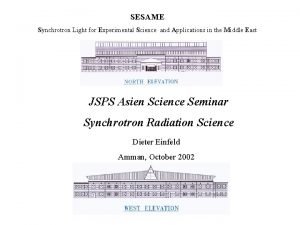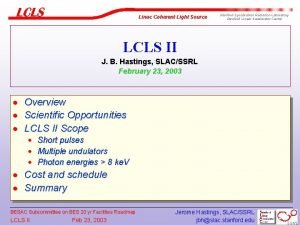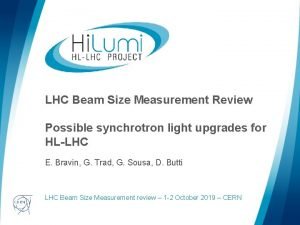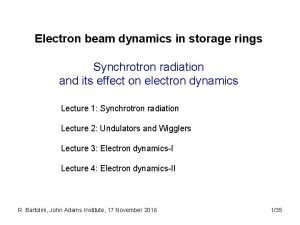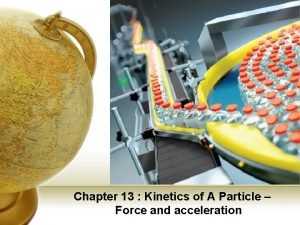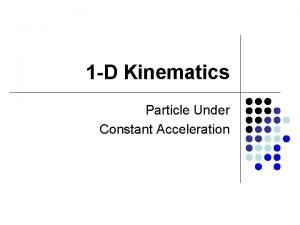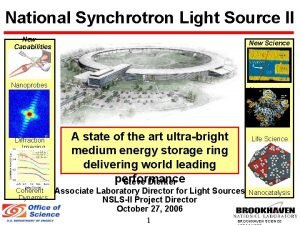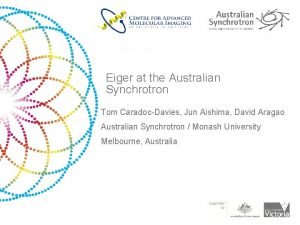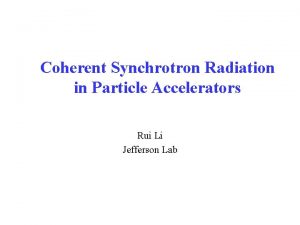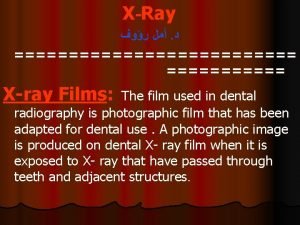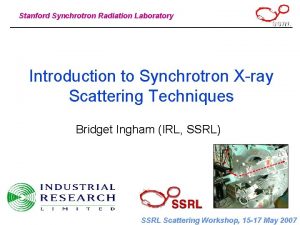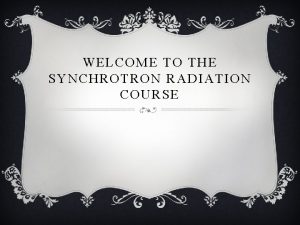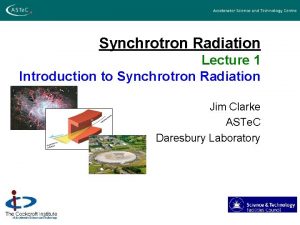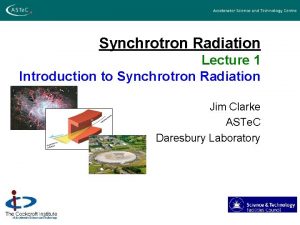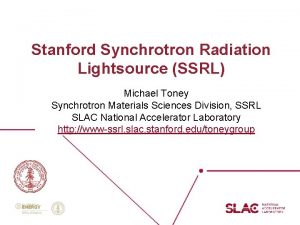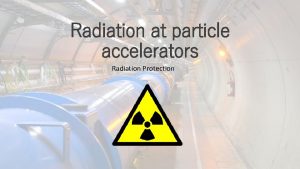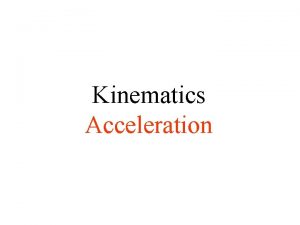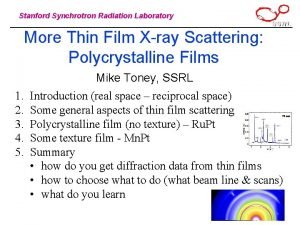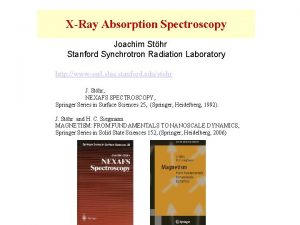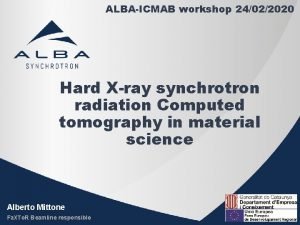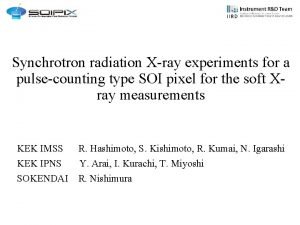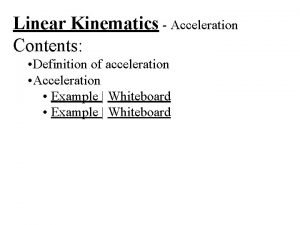Xray synchrotron radiation and particle acceleration Martin Hardcastle


























- Slides: 26

X-ray synchrotron radiation and particle acceleration Martin Hardcastle University of Bristol, UK with Diana Worrall & Mark Birkinshaw (Bristol), Dan Harris (Cf. A), Ralph Kraft et al (Cf. A), Robert Laing et al (Oxford)

Outline • X-ray synchrotron radiation as probe of particle acceleration • FRI (low-power) jets – Problems and successes of a synchrotron model – Cen A and localization of particle acceleration sites: relation to dynamics • FRII hotspots

Introduction • Important to locate sites of jet dissipation, i. e. where jet bulk kinetic energy is transferred into random energy of particles • X-ray synchrotron emission probes this uniquely well • Loss timescale in typical magnetic and photon fields is ~ tens of years • For v < c emitting electrons can travel only a few pc from the site of energization.

FRI X-ray jets (6/15)

Synchrotron emission? 1. Radio and optical is certainly synchrotron 2. Radio / optical / Xray join up (reasonably well) 3. Steep overall X-ray spectra 4. Inverse-Compton impossible (from 3, plus B would have to be << Beq).

Association with deceleration • X-ray and optical jets only in the inner few kpc (almost no exceptions – NGC 6251? ) • 3 C 31 jet exactly in the place where strong dissipation should be taking place (Laing & Bridle) • Short lifetimes imply in situ particle acceleration • Energetics work (easily).

Problems of a synchrotron model 3 C 66 B, a ‘typical’ z ~ 0. 02 (D ~100 Mpc) jet • Diffuse X-ray emission (acceleration mechanism? ) • Point-to-point radio/X-ray spectral differences • Offsets in peaks • Conventional synchrotron spectra don’t fit.

Centaurus A • Clearly there are things going on in these sources that do not fit a simple picture • In general distance means that we are averaging over many loss scales; there must be substructure we are missing • Chandra’s resolution probes the loss scale of ~ few pc in only one source: Cen A (D = 3. 4 Mpc; 1 arcsec = 17 pc). • Observed with Chandra & VLA.

Cen A monitoring 91

Cen A monitoring 02

Cen A monitoring 03

Jet proper motion

New X-ray

Cen A radio/X-ray Arrows indicate compact X-ray features with weak (but now detected) radio counterparts and flat radio-X-ray spectra

Radio/X-ray • Most X-ray knots now have detected, coincident radio counterparts • Some diffuse X-ray emission not resolved into knots, and the radio/X-ray relation is complex; clear edge-brightening. • Knots and diffuse emission spectrally distinct. • Strong X-ray knots are all associated with stationary radio features.

Shocks • Knot spectra imply they are not simply compressions in the flow, but privileged sites for particle acceleration • Plausibly shocks • Base knots can be a standing reconfinement shock, but • Stationary knots further up the jet seem to imply that the jet fluid is running into something (most likely clumps of cold gas).

Particle acceleration • Some may be at shocks – perhaps averaging over shocks & downstream loss regions can account for both offsets and spectral peculiarities. • Diffuse, edge-brightened regions harder to explain in these terms – population of unresolved knots, or different process?

Shocks in FRIIs? • Hotspots in FRIIs conventionally taken to be the sites of jet termination shocks. • Optical emission shows that hotspots can accelerate to high energies (though mechanism not clear for extended optical regions) • What about X-ray emission?

X-ray hotspots • Early X-ray hotspot observations mostly of sources where synchrotron cuts off before optical: inverse Compton (SSC) with B close to Beq. • But we run into problems when looking at weaker hotspots with less well constrained spectra. • Some well-known sources that don’t work with SSC models (Pic A, 3 C 390. 3). • Recently even more extreme sources discovered…

Extreme X-ray hotspots Either we are wrong about inverse-Compton emission or we have synchrotron emission as well/instead in some sources.

3 C sources with hotspots X-ray detections X-ray upper limits • Search for 3 C FRII sources in Chandra archive • Examine ratio R of observation to IC prediction

R and hotspot power

R and hotspot power Not as good a correlation as it looks!

R and beaming Crosses – LERG Boxes – NLRG Circles – BLRG Stars – Quasars Large circles show hotspots that jets enter

Hotspot conclusions • Many low-power hotspots have much more X-ray emission than would be expected on SSC model. • Dominant influence appears to be radio power. Explicable in terms of synchrotron model – greatly increased high-energy losses. Hard to explain on IC model. • Effect of beaming is secondary, but probably still there. Again explicable in synchrotron model.

Summary • In low-power jets X-ray synchrotron probes particle acceleration associated with bulk jet deceleration. • In Cen A at least some of the particle acceleration is localized and can be related to small-scale jet dynamics. • In FRII hotspots synchrotron X-ray may be the best way to understand the bright X-ray emission seen in many hotspots; acceleration mechanism is far from clear as yet.
 Synchrotron radiation
Synchrotron radiation Synchrotron radiation workshop
Synchrotron radiation workshop Synchrotron radiation
Synchrotron radiation Bremsstrahlung radiation
Bremsstrahlung radiation Synchrotron
Synchrotron Synchrotron radiation
Synchrotron radiation Synchrotron radiation
Synchrotron radiation Photon density formula
Photon density formula Light: science & applications
Light: science & applications Stanford
Stanford Bsrtm
Bsrtm Synchrotron radiation
Synchrotron radiation Is the patriarch of the hard castle family
Is the patriarch of the hard castle family Andrea hardcastle ron williamson
Andrea hardcastle ron williamson Kinetics of a particle: force and acceleration
Kinetics of a particle: force and acceleration Relation between angular and linear quantities
Relation between angular and linear quantities Linear acceleration
Linear acceleration Centripetal acceleration tangential acceleration
Centripetal acceleration tangential acceleration Constant acceleration equations
Constant acceleration equations Solar eclipse accel
Solar eclipse accel Radial acceleration
Radial acceleration National synchrotron light source ii
National synchrotron light source ii Psi synchrotron
Psi synchrotron Synchrotron
Synchrotron Synchrotron
Synchrotron Schuller's view mastoid
Schuller's view mastoid Purpose of lead foil sheet in the film packet
Purpose of lead foil sheet in the film packet
